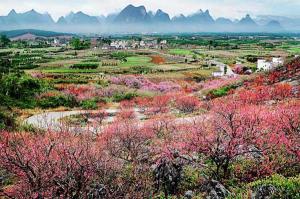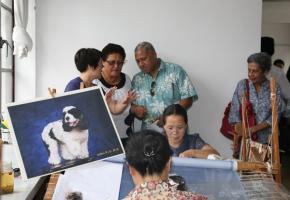Chinese Ethnic Minority Groups
China is home to 56 minority groups, each with its own unique languages, traditions and cultures. The Han Ethnic Group make up 91.5% of the Chinese population and the remaining 8.5% make up the rest. Many of these groups live in their own communities and many towns and village make up of a single minority group. Visiting China’s ethnic minority groups is a dream of many people around the world. Their colorful clothing, ancient traditions, and incredible festivities are truly unforgettable.
Achang:
Found largely in Yunnan Province, the Achang ethnic minority group is famous for its iron forging abilities. They specialize in producing weapons and farming implements. This group is also known for their rice growing abilities.
Bai:
Known for being very artistic, the Bai ethnic minority group can be found mainly in Yunnan, Guizhou, and Hunan Provinces. They consider the color white to be very important and wear a lot of white on their clothing.
Bulang:
The Bulang ethnic minority group lives in agricultural societies and are good at planting trees. Their culture places high regard on musical abilities and music is a very important part of their festivals.
Baoan:
Located in southwest Gansu Province, the Baoan ethnic minority group is Islam. The majority of the Baoan people make handicrafts and can play traditional woodwind and stringed instruments.
Buyei:
The Buyei ethnic minority group can be found in Guizhou Province. Their brocade and embroidery are exceptional and are quite famous for this ability. They are an agricultural people.
Dai:
Known for being Buddhists, the Dai People can be found mainly in Yunnan Province. They are known for their musical abilities and beautiful traditional clothing.
Bai Minority Girls Bai Minority Girls
Dai Minority Clothing Dai Minority Clothing
Dawoer:
A very small minority group, the Dawoer ethnic minority group stress etiquette in their culture. They have a large number of cultural taboos which are unique to their culture.
Deang:
Skilled craftsmen, the Deang ethnic minority group have a very unique tea culture. They are primarily Buddhist and most children at the age of 10 are sent to monasteries for a time.
Dong:
Located on the boarders between Hunan, Hubei, and Guizhou Provinces, the Dong ethnic minority group are famous for their polyphonic choir singing. They are also known throughout China for their Sweet rice and carpentry skills and architectural style.
Dongxiang:
Known for their love of drinking tea, the Dongxiang ethnic minority group members primarily believe in Islam. They are an agricultural people.
Dulong:
A very small minority group, the Dulong ethnic minority group create their own distinctive form of carpets which are extremely beautiful. The group eats two meals a day and believe that there are spirits that control everything.
Elunchun:
Living in Inner Mongolia and Heilongjiang Province, the Elunchun minority group are good at making wares from iron, wood and bone. Their primary food is meat and they are good at hunting.
Dong Minority Men Dong Minority Men
Dong Minority Girls Dong Minority Girls
Ewenke:
Living mostly in the Inner Mongolia Autonomous Region, the Ewenke ethnic minority group are good at singing and dancing. They have wonderful festivals which entail horse racing and wrestling matches.
Gaoshan:
Gaoshan means “High Mountain” in Chinese. The Gaoshan Ethnic minority group are known as being highland dwellers. They live on Taiwan Island and have a fondness for ballads and story telling. In the past, they were head hunters. They have many ceremonies for daily activities.
Gelao:
Located in Guizhou, Guangxi, Yunnan, and Sichuan Provinces, the Gelao ethnic minority group are primarily Taoist. They believe in ancestor worship and are famous for their forging and blacksmithing.
Gin:
Making their living by fishing and farming, the Gin ethnic minority group live primarily in Guangxi Zhuang Autonomous Region. Rice and seafood are their primary food staples.
Han:
Found in virtually every part of China, the Han Chinese have a huge population and are the largest ethnic group in the world.
Hani:
Living primarily in China’s Yunnan Province, the Hani ethnic minority group are polytheists and adore and pray to their ancestors.
Hani Minority Girls Hani Minority Girls
Miao Minority Girls Miao Minority Girls
Hezhen:
The smallest minority group in China, the Hezhen ethnic minority group live in Heilongjiang Province. They believe in Shamanism and their most powerful totems are the bear and the tiger. Fish is their staple food.
Hui:
Distinguished by their practice of Islam, the Hui ethnic minority group are located primarily in Ningxia, Gansu, Qinghai, and Xinjiang Provinces.
Jingpo:
Located in Yunnan Province, the Jingpo ethnic minority group is known for its carving, painting, embroidering, and weaving. They believe that everything possesses a soul which will never die and give respect to nature and each other.
Jinuo:
Believing in animism, the Jinuo ethnic minority group are famous for their Iron Forging Festival. Their staple foods are rice and corn.
Kazakh:
Lovers of music and dance, the Kazakh ethnic minority group has a variety of unique musical instruments. They believe in Islam and can be found in China’s Xinjiang, Gansu, and Qinghai Provinces.
Korean:
Located within China are millions of descendants of Korean immigrants. They are Chinese, but still follow traditional Korean culture. Most speak both Mandarin Chinese and Korean.
Mongolian Horse Races Mongolian Horse Races
Naxi Dancers Naxi Dancers
Keerkezi:
Living in Xinjiang Province, the Keerkezi ethnic minority group are known for their abilities in literature, sports, music, and handicrafts. They are very adept at animal husbandry
Lahu:
Regarding black as the most beautiful color, the Lahu ethnic minority group are Buddhist. They are located in China’s Yunnan Province are have a very small population.
Li:
Living primarily in Hainan Island, the Li ethnic minority group is an agricultural society living on corn, rice, and sweet potatoes. They are known for their animal husbandry and handicrafts.
Lisu:
Consisting of more than 58 unique clans, the Lisu ethnic minority group traditionally live high in the mountains of Yunnan and Sichuan Provinces. They have their own unique dances and musical instruments. They have different songs and dances for different occasions.
Luoba:
Making their living by agriculture and hunting, the Luoba ethnic minority group reside in China’s Tibet Province. Yong boys are trained to hunt at an early age.
Man:
Famous for their horse riding, hunting, and archery, the Man ethnic minority group can be found all over China. They culture can be found around the world, including the Qipao (Cheongsam) and Magua (Mandarin Dress).
Elderly Naxi Women Elderly Naxi Women
Shui Minority Woman Shui Minority Woman
Maonan:
Living in Guangxi Zhuang Autonomous Region, more than 80% of the Maonan ethnic minority group have the same surname: Tan. Their towns were organized by clan and traditionally marriages were arranged by parents while still children.
Miao:
The Miao ethnic minority group has a fairly large population. They are skilled in handicrafts such as weaving and embroidery, and paper cutting. They can be found in Guizhou, Hunan, Yunnan, Sichuan, Guangxi, Hainan, Guangdong, and Hubei Provinces.
Monba:
Distributed throughout Tibet, the Monba ethnic minority group have a very long history. Their staple foods are corn, rice, and buckwheat. They are known for weaving with bamboo strips and vines.
Mongol:
Known as the minority group that lives on horseback, the Mongols live in Inner Mongolia. Their festivals are particularly lively with horse racing and wrestling. Their staple foods are milk and meat.
Miao:
The Miao ethnic minority group has a fairly large population. They are skilled in handicrafts such as weaving and embroidery, and paper cutting. They can be found in Guizhou, Hunan, Yunnan, Sichuan, Guangxi, Hainan, Guangdong, and Hubei Provinces.
Mulao:
A small minority group living in Guangxi Zhuang Autonomous Region, the Mulao ethnic minority group believe in the spirits of nature. They are known for their blacksmithing and pottery abilities.
Naxi:
Believing in the Dongba Religion, the Naxi people are famous for their music, handicraft, and written language, which is the only hieroglyphic language still in use in the world. They live in Yunnan, Sichuan, and Tibet Provinces.
Tibetan Weaver Tibetan Weaver
Uygur Instrument Maker Uygur Instrument Maker
Nu:
The Nu ethnic minority group are located in the southwest of Yunnan Province. They are known for their love of music and their skill at playing musical instruments.
Pumi:
Believing that their lives are influenced by the gods, the Pumi ethnic minority group are agricultural societies and are quite accomplished at animal husbandry. They live in Sichuan Province.
Qiang:
Living off beef, mutton, chicken, fish, corn, and potatoes, the Qiang ethnic minority group live in Sichuan Province’s Aba Tibetan Autonomous Prefecture.
Russian:
Their ancestors originated in Russia and immigrated to China during the 18th century. The Russian ethnic group mostly live in Xinjiang Uygur Autonomous Region and celebrate western holidays such as Christmas and Easter.
Sala:
Making a living from horticulture and agriculture, the Sala ethnic minority group live in Qinghao, Gansu, and Xinjiang Provinces. Their clothing is very similar to other Muslim groups in China; the Sala people love music and are famous for their ability at the Kouxuan, a metal stringed instrument played only by women.
She:
The largest minority group in China’s Fujian Province, the She ethnic minority group’s staple foods are beans, rice, corn, and potatoes. They believe in ancestor worship and totems.
Yao Minority Women Yao Minority Women
Zhuang Minority Girls Zhuang Minority Girls
Shui:
Located in Guizhou Province, the Shui minority group are skilled jewelry and batik cloth making.
Tajike:
Believing in Islam, the Tajike people place great importance on etiquette. They live in China’s Xinjiang Uygur Autonomous Region.
Tataer:
Mainly living in Xinjiang Uygur Autonomous Region, the Tataer group have their own language, and follow Islam. They are dependent on agriculture and animal husbandry.
Tu:
Practicing Animism and Taoism, the Tu people make a living from agriculture, and animal husbandry. They live in China’s Qinghai and Gansu Provinces.
Tajike:
Believing in Islam, the Tajike people place great importance on etiquette. They live in China’s Xinjiang Uygur Autonomous Region.
Tujia:
With a population of over 8 million people, the Tujia ethnic minority group is the 6th largest group in China. They live on the borders of Hunan, Hubei, and Guizhou Provinces. They are known for their singing and song composing.
Uygur:
Believing in Islam and living in Xinjiang Uygur Autonomous Region, the Uygur ethnic minority group make their livelihood from agriculture and fishing. They are known for their foods, which can be found throughout China.
Uzbek:
A Turkic people living in China’s Xinjiang Uygur Autonomous Region, the Uzbek ethnic minority believe in Islam. They live off of animal husbandry and the creating of handicrafts.
Wa:
Living in Yunnan Province, the Wa ethnic minority group live off of agriculture. Some members of the Wa group believe in Buddhism and Christianity.
Xibo:
Living off of animal husbandry and agriculture, the Xibo ethnic minority group are located in Jilin, Liaoning, and Xinjiang Uygur Autonomous Region. Their staple foods are corn, rice, and potatoes.
Yao:
A mountainous people, the Yao group live in the south of China. They are known for their loving of tea and homemade wines.
Yi:
Believing in Islam, the Tajike people place great importance on etiquette. They live in China’s Xinjiang Uygur Autonomous Region.
Yugur:
Living mainly in Gansu Province, the Yugur ethnic minority group live off of stock breeding and believe in Lamaism. They are known for their folk tales and ballads.
Zhuang:
The largest minority group in China, the Zhuang Ethnic minority group live in Guangxi Zhuang Autonomous Region. They love salty and sour dishes. They are known for making sticky rice Zhongzi (dumplings). They love to drink rice wine and oil tea.

 LGBT China Tours
LGBT China Tours  Luxury China Tours
Luxury China Tours Accessible China Tours
Accessible China Tours

